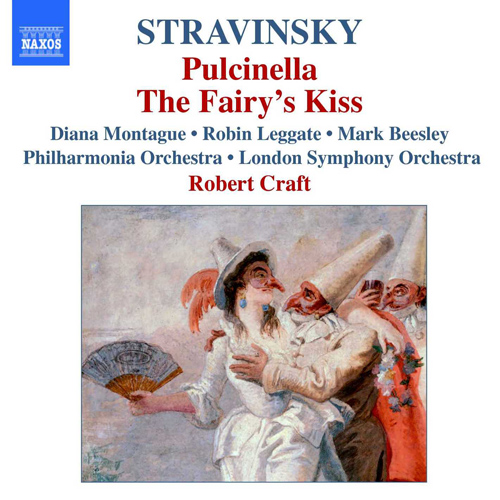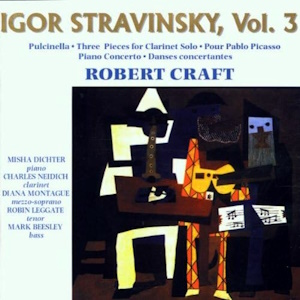 |
|
1 CD -
8.557503 - (c) 2006
|
|
IGOR
STRAVINSKY | ROBERT CRAFT - Volume 5
|
|
|
|
|
|
|
|
| Igor STRAVINSKY
(1882-1971) |
Pulcinella
(1920) - Ballet in One Act
With Song
|
* |
|
36' 22" |
|
|
-
Ouverture
|
|
1' 56" |
|
1 |
|
-
Serenata: Mentre l'erbetta
(Tenor)
|
|
2' 29" |
|
2 |
|
-
(A) Scherzino; (B) Allegro; (C)
Andantino; (D) Allegro
|
|
6' 00" |
|
3 |
|
-
Allegretto: Contento
forse vivere (Soprano)
|
|
1' 42" |
|
4 |
|
-
Allegro assai
|
|
1' 55" |
|
5
|
|
-
Allegro (alla breve); Con
queste paroline (Bass)
|
|
3' 32" |
|
6 |
|
-
Largo: Sento dire no' ncè pace
(Terzetto)
|
|
1' 02" |
|
7 |
|
-
Chi disse cà la femmena
(Tenor)
|
|
0' 26" |
|
8 |
|
-
Allegro: Ncè sta quaccuna po'
(Soprano and Tenor)
|
|
0' 32" |
|
9 |
|
-
Presto: Una te fa la 'nzemprece
(Tenor)
|
|
1' 04" |
|
10 |
|
-
Larghetto
|
|
0' 25" |
|
11 |
|
-
Allegro alla breve
|
|
1' 11" |
|
12 |
|
-
Allegro moderato: Tarantella
|
|
1' 10" |
|
13 |
|
-
Andantino: Se tu m'ami
(Soprano)
|
|
2' 08" |
|
14 |
|
-
Toccata
|
|
0' 55" |
|
15 |
|
-
Allegro moderato: Gavotta with two
variations (Allegretto, Allegro)
|
|
3' 58" |
|
16 |
|
-
Vivo
|
|
1' 34" |
|
17 |
|
-
Minuet: Pupillette, fiammette
(Terzetto)
|
|
2' 14" |
|
18 |
|
-
Finale: Allegro assai
|
|
2' 09" |
|
19 |
|
|
|
|
|
|
|
The
Fairy's Kiss (1928) |
**
|
|
42' 01" |
|
|
- Scene I
|
|
8' 05" |
|
20 |
|
-
Scene II
|
|
10' 48" |
|
21 |
|
-
Scene III
|
|
18' 32" |
|
22 |
|
-
Scene IV
|
|
4' 36" |
|
23 |
|
|
|
|
Pulcinella
Diana
Montague, Mezzo-soprano
Robin Leggate, Tenor
Mark Beesley, Bass
PHILHARMONIA ORCHESTRA
Robert CRAFT
|
The Fairy's
Kiss
LONDON
SYMPHONY ORCHESTRA
Robert CRAFT
|
|
|
|
|
|
Recorded
at: |
|
Abbey
Road Studio One, London (England):
- 3 to 5 and 8 January 1995 (The
Fairy's Kiss)
- 31 January and 1 Febraury 1997
(Pulcinella)
|
|
|
Live / Studio
|
|
Studio |
|
|
Producer |
|
Michael
Fine (The Fairy's Kiss)
Gregory K. Squires (Pulcinella)
|
|
|
Engineer |
|
Simon
Rhodes (The Fairy's Kiss)
Michael Sheady (Pulcinella)
|
|
|
Assistant
Engineer |
|
David
Flowers (Pulcinella)
|
|
|
Naxos Editions
|
|
Naxos
| 8.557503 | 1 CD | LC 05537 |
durata 78' 23" | (c)
2006 | DDD
|
|
|
KOCH
(previously released) |
|
Koch
International, Vol. III
| 3-7470-2 | 1 CD | (p)
1999 | DDD (Pulcinella)
Koch
International,
Vol. I |
3-7276-2 | 1
CD | (p) 1996
| DDD (The
Fairy's Kiss)
|
|
|
MusicMasters
(previously released) |
|
MusicMasters,
Vol. IV | 01612-67113-2
| 1 CD | (p) 1993 | DDD
(Agon)
|
|
|
Cover |
|
Pulcinella in
Love, 1793 by Giovanni
Domenico Tiepolo (1727-1804)
(akg-images / Cameraphoto)
|
|
|
Note |
|
-
|
|
|
|
|
|
MusicMASTERS
CLASSICS
Release (1991-1998)

|
KOCH
INTERNATIONAL
Release (1996-2002)
 1 CD -
3-7470-2 - Volume III
1 CD -
3-7470-2 - Volume III
(c) 1999 *

1 CD -
3-7276-2 -
Volume I
(c) 1996 **
|
Stravinsky’s
one-act ballet with song, Pulcinella,
is no mere re-working of music
by Pergolesi and other
18th-century Italian composers.
Instead he uses the originals as
a springboard for
experimentation, transforming
the music into a modern work by
means of quirky instrumentation
(for example, the jazzy
glissandos of the double-bass
solo), ostinato melodies, and
other 20th-century devices. The
ballet The Fairy’s Kiss,
at another extreme, is a largely
original composition. Stravinsky
greatly altered, developed, and
elaborated melodies from early
piano pieces and songs by
Tchaikovsky, expanding them into
sizeable ballet numbers to form
a continuous dance symphony.
Pulcinella (1920): Ballet in
One Act with Song
At the time of the first
performance of Pulcinella
the music was attributed to
“Igor Strawinsky d’après
Giambattista Pergolesi”. In fact
fewer than half of the pieces
that Stravinsky arranged for an
orchestra of 33 and three
singers were by Pergolesi
(1710–1736), whose entry in The
New Grove Dictionary of Music
and Musicians lists more
“spurious” and “doubtful”
creations than certifiably
authentic ones. As much material
comes from the trio sonatas of
the Venetian composer Domenico
Gallo (active c. 1730) as from
his Neapolitan contemporary.
Further, the score’s most
popular song, “Se tu m’ami,”
is by Parisotti, not Pergolesi.
The eighteenth-century copies
from which Stravinsky worked are
unsigned. Dyagilev told
Stravinsky that they had come
from a conservatory library in
Naples, but in actuality most of
them were transcribed in the
British Museum.
The libretto is in the hand of
Léonide Massine, who also
choreographed the ballet. The
scene is set in Naples and the
characters are taken from the Commedia
dell’Arte. Rosetta and
Prudenza respond to the
serenading of Caviello and
Florindo by dousing them with
water. A Dottore arrives
and chases the musical pair
away. Pulcinella enters, dances,
and attracts Prudenza, who tries
to embrace him. He rejects her.
Rosetta appears, chaperoned by
her father Tartaglia. She tells
him of her love for Pulcinella,
for whom she dances. He kisses
her, but is seen by Pimpinella,
his mistress, who becomes
jealous. Caviello and Florindo
re-enter in disguise, and
Florindo, jealous of Pulcinella,
stabs him. When the would-be
lovers leave, Pulcinella
cautiously gets up. Four little
Pulcinellas enter, carrying the
body of Furbo disguised as
Pulcinella. They place the body
on the floor. The Doctor and
Tartaglia enter with their
daughters, who are horrified. A
magician appears and revives the
corpse. When the fathers refuse
to believe the miracle, the
magician removes his cloak and
reveals himself as the real
Pulcinella. The revived corpse
is his friend Furbo. Pimpinella
enters but is frightened at the
sight of two Pulcinellas.
Florindo and Caviello return,
disguised as Pulcinellas, hoping
for more satisfaction in their
amorous pursuits. The confusion
caused by four Pulcinellas
prompts Furbo to resume his
disguise as magician. At the
end, the “Pulcinella” couples,
including Pimpinella and the
ballet’s eponymous hero, are
reunited and married.
Further to complicate the
distinction of identities, the
musical numbers do not
correspond to dramatic
situations, and the texts of the
vocal pieces - six of the seven
were borrowed from three
different operas - are unrelated
to the stage action. Some of
them, but not including Contento
forse vivere, from
Metastasio’s Adriano in Siria,
are in Neapolitan dialect.
Unpromising as all of this may
sound, the vocal pieces, one
aria for the bass, three for the
tenor, two for the soprano, one
duet, and two trios, seem to
turn the ballet into an opera
with a cohesive dramatic entity.
Stravinsky’s chief means of
distancing himself from the
eighteenth century is in the
instrumentation, which, almost
alone, transforms the music into
a modern work. The small
orchestra, with strings divided
into ripieni and a concertante
solo quintet, sounds like, but
never completely like, an
eighteenth-century ensemble. One
explanation for this is that the
trombone, employed in the
eighteenth century chiefly in
sacred or solemn music, is here
the instrument of a 1920s jazz
band, as the glissandos confirm.
Other modern instrumental
touches include the use of flute
and string harmonics, and string
effects such as flautando,
saltando, and the
non-arpeggiated double-stop
pizzicato. Still other
twentieth-century orchestral
novelties are the alternation of
string and wind ensembles for
entire pieces, as in,
respectively, the Gavotta
and the Tarantella, the
exploitation of wind-instrument
virtuosity - the whirligig
velocity of the flutes in the C
minor Allegro - and the
high ranges of the double-reeds
(the oboe’s high A, and a
bassoon tessitura fully a fifth
higher than would be expected in
eighteenth-century music). The
contrabass, too, in its
syncopated, jazz-style solo,
explores a higher altitude than
is normal in Old Music, but this
bass riff does not change a note
of the original. Indeed, what is
most surprising about the whole
of Pulcinella is how
closely Stravinsky follows his
melodic and figured-bass
skeletons, and how little he
alters the harmonic and melodic
structure. The bass vocal part
also requires an exceptional
high-register, which the vocal
score wrongly transposes an
octave lower.
The Fairy’s Kiss
Scene I - The lullaby in the
storm:
A mother, lulling her child,
struggles through a storm. The
Fairy’s attendant sprites appear
and pursue her. They separate
her from the infant and carry
him off. The Fairy herself
appears. She approaches the
child and enfolds him with her
tenderness. Then she kisses him
on the forehead and goes away.
Now he is alone. Country folk,
passing, find him, search in
vain for his mother, and, deeply
distressed, take him with them.
Scene II - A village fête:
A peasant dance is in progress,
with musicians on the stage.
Among the dancers are a young
man and his fiancée. The
musicians and the crowd
disperse, and, his fiancée going
away with them, the young man
remains alone. The Fairy
approaches him in the guise of a
gypsy woman. She takes his hand
and tells his fortune, then she
dances, and, ever increasingly,
subjects him to her will. She
talks of his romance and
promises him great happiness.
Captivated by her words, he begs
her to lead him to his fiancée.
Scene III - At the mill:
Guided by the Fairy, the young
man arrives at the mill, where
he finds his fiancée among her
friends playing games. The Fairy
disappears. They all dance; then
the girl goes with her friends
to put on her wedding veil. The
young man is left alone.
Scene IV
The Fairy appears, wearing a
wedding veil. The young man
takes her for his bride. He goes
towards her, enraptured, and
addresses her in the terms of
warmest passion. Suddenly the
Fairy throws off her veil.
Dumbfounded, the young man
realizes his mistake. He tries
to free himself, but in vain; he
is defenseless before the
supernatural power of the Fairy.
His resistance overcome, she
holds him in her power. Now she
will bear him away to a land
beyond time and place, where she
will again kiss him, this time
on the sole of the foot.
The Lullaby of the Eternal
Place:
The Fairy’s attendant sprites
group themselves in slow
movements of great tranquillity
before a wide décor representing
the infinite space of the
heavens. The Fairy and the young
man appear on a ridge. She
kisses him to the sound of her
lullaby.
The young man, of course, is
Tchaikovsky himself, the Fairy
his Mephistophelean muse. The
ending of Stravinsky’s homage to
his beloved forbear, one of the
most moving he ever wrote, is
rarely heard in ballet
performances at present. George
Balanchine’s abbreviated version
of the ballet concludes with the
peasants’ dance, which is in the
dominant, not the tonic, of its
key.
Commentaries on The Fairy’s
Kiss generally attempt to
establish parallels between
Pergolesi– Stravinsky and
Tchaikovsky–Stravinsky, but the
only exact one is that both
unwitting collaborators were
composers of the past. The
unique entirely original music
in Pulcinella is a short
bridge section and the
introduction to the Tarantella.
The Fairy’s Kiss, at
another extreme, is largely
original composition. Stravinsky
greatly altered, developed, and
elaborated melodies from early
piano pieces and songs by
Tchaikovsky, expanding them into
sizable ballet numbers forming a
continuous dance symphony. He
was so familiar with
Tchaikovsky’s stylistic
features, melodic, harmonic, and
instrumental, that he could
compose more Tchaikovsky
himself.
The sketches for The Fairy’s
Kiss do not contain a
single reference to sources in
Tchaikovsky, but perhaps more
than those for any other
Stravinsky work they confirm T.
S. Eliot’s dictum that “the mark
of the master is to be able to
make small changes that will be
highly significant”. In some
instances Stravinsky simply
changes Tchaikovsky’s tempo.
Thus the Scherzo humoresque
becomes the slow-tempo song at
the beginning of Scene III of
the ballet, and Tchaikovsky’s Allegretto
grazioso is wholly
transformed simply by being
played at half tempo: Stravinsky
retains the melody, rhythm, and
even the harmony of the
original. Stravinsky had a
genius for perceiving the
slow-tempo lyrical piece in the
fast-tempo one, the attractive
melody obscured by the dull
rhythm. The male dancer’s
Variation in Scene III changes
Tchaikovsky’s 3/4 Nocturne
to 6/8 and his monotonously
repeated eighthnotes (quavers)
to quarters (crotchets) followed
by eighths (quavers). I should
add that the ballet also
transposes the piece from A down
to G, but that, clearly, was to
accommodate the high notes of
the horn.
The most remarkable
transformation in The
Fairy’s Kiss is that of
the early song “Both Painful and
Sweet” into the Ballad
that concludes Scene II. In the
first five notes of the theme,
Stravinsky reverses the melodic
sequence E, C sharp, D natural,
to E, C natural, D sharp,
thereby changing A major to A
minor, while preserving the
ambitus. He also rewrites
Tchaikovsky’s rhythmic pattern
of quarter-note (crotchet) beats
and eighth-note (quaver)
offbeats to on-the-beat
triplets, with a rest replacing
the third note, as in the piano
and string ostinato in the first
movement of the 1945 Symphony;
this transforms the mood from
resolution to agitation. What
amazes us, however, is the
mileage that Stravinsky gets out
of this fragment in its
development, repeating it in
different octaves, progressively
slower tempos, and longer
note-values, until, at the end
of the scene, the bass clarinet
plays it slowly beneath six
ascending octave scales in the
flute, the first four notes of
which are in Stravinsky’s A
minor, the last four in
Tchaikovsky’s A major, a subtle
collaboration indeed.
Robert
Craft
|
|
|
|
|

